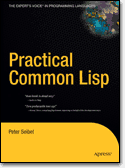
|
FreeComputerBooks.com
Links to Free Computer, Mathematics, Technical Books all over the World
|
|
- Title Practical Common Lisp
- Author(s) Peter Seibel
- Publisher: Apress; 1st ed. 2005. Corr. 3rd printing edition (April 11, 2005)
- Paperback 500 pages
- eBook HTML and PDF
- Language: English
- ISBN-10: 1590592395
- ISBN-13: 978-1590592397
- Share This:

|
it has a fresh view on the language and the examples in the later chapters are usable in your day-to-day work as a programmer. If you're interested in Lisp as it relates to Python or Perl, and want to learn through doing rather than watching, Practical Common Lisp is an excellent entry point.
Lisp is often thought of as an academic language, but it need not be. This is the first book that introduces Lisp as a language for the real world.
Practical Common Lisp presents a thorough introduction to Common Lisp, providing you with an overall understanding of the language features and how they work. Over a third of the book is devoted to practical examples such as the core of a spam filter and a web application for browsing MP3s and streaming them via the Shoutcast protocol to any standard MP3 client software (e.g., iTunes, XMMS, or WinAmp). In other "practical" chapters, author Peter Seibel demonstrates how to build a simple but flexible in-memory database, how to parse binary files, and how to build a unit test framework in 26 lines of code.
About the Authors-
Peter Seibel is a serious developer of long standing. In the early days of the web, he hacked Perl for Mother Jones Magazine and Organic Online. He participated in the Java revolution as an early employee at WebLogic which, after its acquisition by BEA, became the cornerstone of the latter's rapid growth in the J2EE sphere. He has also taught Java programming at UC Berkeley Extension.
- LISP and Common LISP
- Artificial Intelligence, Machine Learning, and Logic Programming
- Prolog Programming
- Computer and Programming Languages
 Similar Books:
Similar Books:
-
 Introduction to newLISP (WikiBooks)
Introduction to newLISP (WikiBooks)
You'll find newLISP easy to learn and powerful, combining some of the power and elegance of classic LISP with the facilities of a modern scripting language, such as regular expressions, network functions, Unicode support, multitasking, and many others.
-
 On Lisp: Advanced Techniques for Common Lisp (Paul Graham)
On Lisp: Advanced Techniques for Common Lisp (Paul Graham)
Written by a Lisp expert, this is the most comprehensive tutorial on the advanced features of Lisp for experienced programmers. It shows how to program in the bottom-up style that is ideal for Lisp programming.
-
 Algorithmic Composition: Music Composition using Common LISP
Algorithmic Composition: Music Composition using Common LISP
This book provides an overview of procedural approaches to music generation. It introduces programming concepts through many examples written using the Common LISP and Common Music for music composition and sound synthesis.
-
 Common LISP - The Language, 2nd Edition (Guy L. Steele JR.)
Common LISP - The Language, 2nd Edition (Guy L. Steele JR.)
This is the Lisp programmers' bible. If you need to know the official specification, every function defined in Common Lisp can be found in here somewhere. Anyone vaguely serious about programming in Lisp should keep a copy of this book for reference.
-
 Lisp Hackers: Interviews with 100x More Productive Programmers
Lisp Hackers: Interviews with 100x More Productive Programmers
Overall, this book should give an insight into why people use Lisp, as well as help the readers gain some new experience and improve as programmers. It's a collection of short interviews with 14 prominent individuals from different parts of the world.
-
 Paradigms of Artificial Intelligence Programming: in Common Lisp
Paradigms of Artificial Intelligence Programming: in Common Lisp
This book is an overview of classical artificial intelligence (AI) programming via actual implementation of landmark systems (case studies). It teaches advanced Common Lisp techniques in the context of building major AI systems.
-
 Let Over Lambda - 50 Years of Lisp (Doug Hoyte)
Let Over Lambda - 50 Years of Lisp (Doug Hoyte)
This book is one of the most hardcore computer programming books out there. Starting with the fundamentals, it describes the most advanced features of the most advanced language: Common Lisp.
-
 Successful Lisp: How to Understand and Use Common Lisp
Successful Lisp: How to Understand and Use Common Lisp
This book is written with the professional programmer in mind. Using a hands on approach it introduces the ANSI Common Lisp standard. Practical examples of working code provide an in depth view of Common Lisp programming paradigms.
-
 Common LISP: A Gentle Introduction to Symbolic Computation
Common LISP: A Gentle Introduction to Symbolic Computation
This highly accessible introduction to Lisp is suitable both for novices approaching their first programming language and experienced programmers interested in exploring a key tool for artificial intelligence research.
-
 Common LISP: An Interactive Approach (Stuart Charles Shapiro)
Common LISP: An Interactive Approach (Stuart Charles Shapiro)
The text uses a tutorial style that focuses on learning by interaction and experimentation. The text also thoroughly covers programming in Pure LISP before programming in Imperative LISP so that students get used to recursive programming.
-
 ANSI Common LISP (Paul Graham)
ANSI Common LISP (Paul Graham)
This book provides an excellent introduction to Common Lisp. In addition to chapters covering the basic language concepts, there are sections discussing the Common Lisp object system (CLOS) and speed considerations in Lisp.





